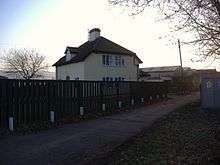Weston, Clevedon and Portishead Light Railway
The Weston, Clevedon and Portishead Light Railway (WCPR) was conceived and built initially as a tramway to link the three small North Somerset coastal towns of Weston-super-Mare, Clevedon and Portishead in the 1880s.
| Overview | |
|---|---|
| Headquarters | Clevedon |
| Locale | England |
| Dates of operation | 1897–1940 |
| Technical | |
| Track gauge | 1,435 mm (4 ft 8 1⁄2 in) standard gauge |
| Length | 13.8 mi (22.2 km) |
Overview
Weston, Clevedon and Portishead Railway | |||||||||||||||||||||||||||||||||||||||||||||||||||||||||||||||||||||||||||||||||||||||||||||||||||||||||||||||||||||||||||||||||||||||||||||||||||||||||||||||||||||||||||||||||||||||||||||||||||||||||||||||||||||||||
|---|---|---|---|---|---|---|---|---|---|---|---|---|---|---|---|---|---|---|---|---|---|---|---|---|---|---|---|---|---|---|---|---|---|---|---|---|---|---|---|---|---|---|---|---|---|---|---|---|---|---|---|---|---|---|---|---|---|---|---|---|---|---|---|---|---|---|---|---|---|---|---|---|---|---|---|---|---|---|---|---|---|---|---|---|---|---|---|---|---|---|---|---|---|---|---|---|---|---|---|---|---|---|---|---|---|---|---|---|---|---|---|---|---|---|---|---|---|---|---|---|---|---|---|---|---|---|---|---|---|---|---|---|---|---|---|---|---|---|---|---|---|---|---|---|---|---|---|---|---|---|---|---|---|---|---|---|---|---|---|---|---|---|---|---|---|---|---|---|---|---|---|---|---|---|---|---|---|---|---|---|---|---|---|---|---|---|---|---|---|---|---|---|---|---|---|---|---|---|---|---|---|---|---|---|---|---|---|---|---|---|---|---|---|---|---|---|---|
| |||||||||||||||||||||||||||||||||||||||||||||||||||||||||||||||||||||||||||||||||||||||||||||||||||||||||||||||||||||||||||||||||||||||||||||||||||||||||||||||||||||||||||||||||||||||||||||||||||||||||||||||||||||||||
It was a standard gauge light railway which operated on a shoestring. It was 13.8 miles (22.2 km) long with 19 stations or halts most of which had a small shelter and no platform. The line ran through sparsely-populated and level countryside. Most of the locomotives and rolling stock were bought second-hand from various sources, making a varied collection.
The section from Weston-super-Mare to Clevedon opened in 1897, and the extension to Portishead in 1907. The railway was built with economy in mind and there were no major station buildings or bridges. After years of financial struggle, the line closed on 18 May 1940.
Early history
The WC&PR was originally proposed as a standard gauge tramway in 1884 by the Weston-Super-Mare, Clevedon & Portishead Tramways Company to link the three small coastal towns. The line was planned to run on the street along the Boulevard in Weston-super-Mare and from there off-road apart from numerous road crossings all of which were to be on the level. An Act of Parliament to authorise the construction of the railway was passed on 6 August 1885.
Building of the Weston-super-Mare to Clevedon section of the railway began in 1887 but due to various legal and financial problems, progress was very slow, and the time limit of the Act expired requiring further Acts to be passed on 25 July 1890 and December 1891. Due to these delays some of the track had to be re-laid before the line opened because sleepers had rotted. The track along the Boulevard in Weston-super-Mare was taken up before the line opened due to complaints from the council. The section finally opened on 1 December 1897. Two years after the opening, the tramway was designated a light railway and the name was changed to the Weston, Clevedon & Portishead Light Railway Company.
Portishead extension

The extension to Portishead had been planned from the beginning, but financial constraints delayed its construction. It required another Act of Parliament, which was passed in August 1899, There were many objections to the proposed extension, one of which was that the line was to run through the streets in Clevedon. These objections were overcome, but a man with a flag had to lead trains across the street at 4 mph. The extension to Portishead was built as a light railway and opened on 7 August 1907.
Other features
Links to the Great Western Railway were provided at Clevedon and Portishead, and in 1915 a short branch to a wharf at Wick St. Lawrence on the River Yeo was built. Sidings served three stone quarries in the Gordano Valley.
Financial problems
The finances of the railway were always precarious and became serious by 1905. It entered receivership in 1909 and was in decline up to the outbreak of World War II, not helped by the increase in road traffic. It had relied on the transport of stone from the Black Rock quarries and the decline in this business made things worse. The railway spent 31 of its 43 years in the hands of receivers.
Colonel HF Stephens
Col. H. F. Stephens took over the running of the WC&PR in 1911. He was known as the 'Light Railway King' because he ran a number of similar railways, and though he got the costs under control, the financial situation remained poor. After his death in 1931 W. H. Austen followed him as manager until the railway closed.
Closure
Due to an ever-worsening financial state, the Company applied for a Court order to close the line. The Great Western Railway purchased the line (but not the land) to use it for storage, and for a short time up to 200 coal wagons were stored on the line. It was decided to remove the track for use in the war effort, and it was cleared between October 1942 and late 1943. The legality of the ownership of the land was a long-running issue that was never properly resolved.
The line today
Due to the lack of major infrastructure, there are few obvious remains of the line. Still surviving is a small bridge over a rhyne in Portishead, the remains of a bridge over the River Yeo, and the wharf. Much of the route of the track bed survives, a small part of which can be walked on Weston Moor reserve in the Gordano Valley. There are plans to convert some of the track bed to a cycle path as part of the National Cycle Network.
WC&P Railway Group
The WC&P Railway Group was formed in November 2006, to attempt to preserve what was left of the railway.
References
External links
| Wikimedia Commons has media related to Weston, Clevedon and Portishead Railway. |
Further reading
- Maggs, Colin G. (1990). The Weston Clevedon & Portishead Light Railway: The Oakwood Press. ISBN 0-85361-388-5.
- Mitchell,Vic and Smith, Keith (2003). Branch Lines to Clevedon and Portishead. Midhurst: Middleton Press. ISBN 1-904474-18-7.
- Redwood, Christopher (1981). The Weston, Clevedon and Portishead Railway: Sequoia Publishing. ISBN 0-905466-42-X.
- Scott-Morgan, John (1978). The Colonel Stephens Railways: A Pictorial Survey. Newton Abbot: David & Charles. ISBN 0 7153 7544 X.CS1 maint: ref=harv (link)
- Smith, Martin (1992). The Railways of Bristol & Somerset. Shepperton: Ian Allan. ISBN 0-7110-2063-9.
- Strange, Peter (1989). The Weston Clevedon & Portishead Railway : Twelveheads Press. ISBN 0-906294-19-3